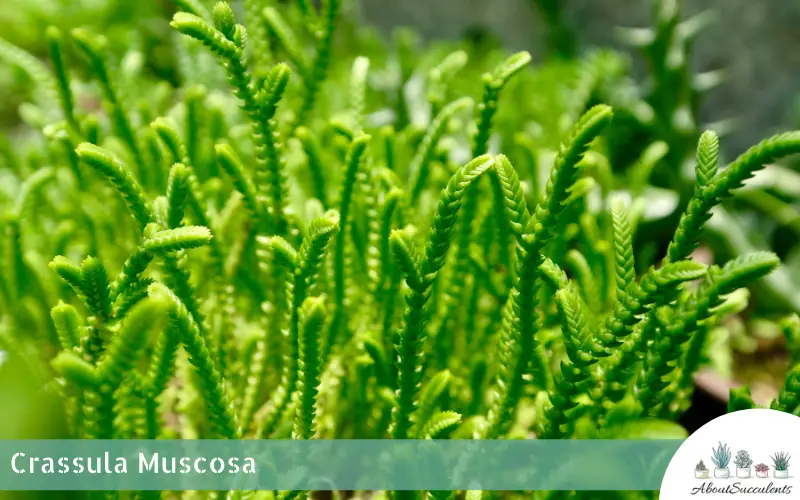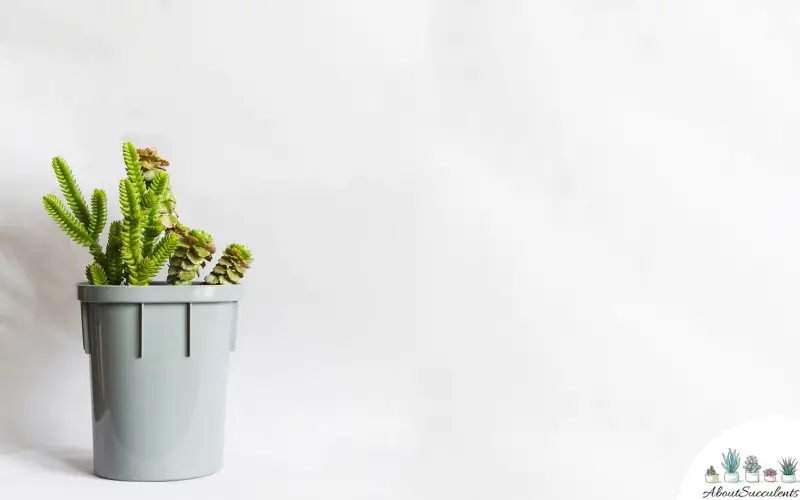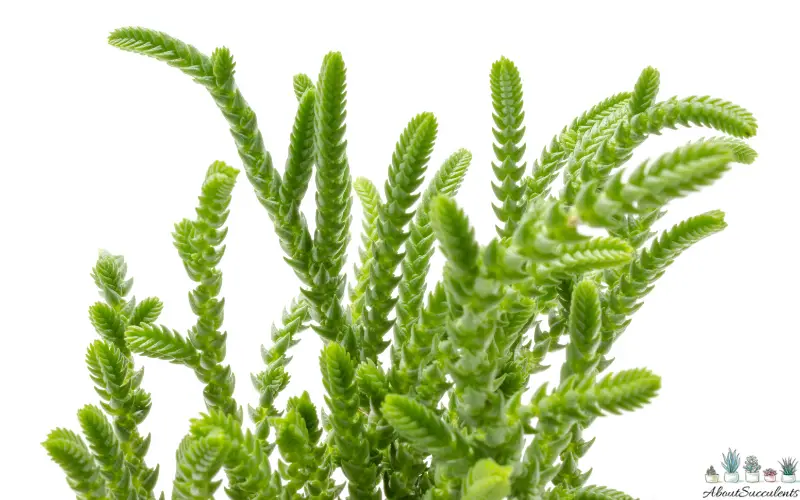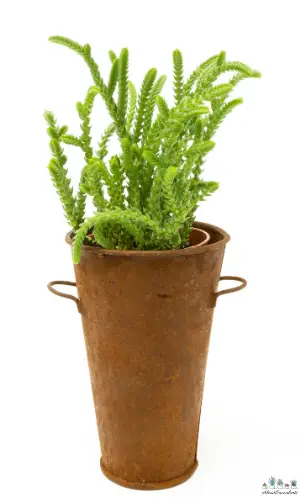
Crassula Muscosa is a small succulent that grows as a dense bush. Its branches are covered in densely-arranged small leaves that give it an appearance of having scaly tails. This plant belongs to the Crassulaceae family and it’s also known by the following names: “Watch Chain”, “Lizard’s Tail”, “Princess Pine” and “Zipper Plant”. The succulent produces yellow-green flowers that bloom between the leaves. The flowers carry a strong musky scent that can be unpleasant to some people.
Crassula Muscosa can grow up to 12-inches tall or 30 cm and is native to Namibia and the South African cities located in the Eastern Cape, Free State, Northern Cape, Western Cape, and North West.
General Information:
Also Known As: Watch Chain, Lizard’s Tail, Pine Princess, Zipper Plant
Plant Family: Crassulaceae
Origin: Namibia and South Africa
Height: 12-inches tall (30cm)
Exposure: 6 hours of sunlight
Water Needs: Frequent watering in the summer; low watering in the winter
Soil Type: Cactus Mix or a combination of half perlite or pumice and half potting soil.
Soil pH: Acidic (5.1 to 5.5) or Strongly Acidic (5.6 to 6.0)
Maintenance Requirements: Low
Tolerance: Cold; should be brought indoors when temperatures fall below 20° F (-6.7° C)
How to Grow and Care for Crassula Muscosa / Watch Chain

The flowing leaves and beautiful flowers make the succulent a welcome addition indoors. When planted near a window that brings in generous amounts of sunlight, its leaves will grow more tightly-compact. If located near a window with less sunlight, the leaves will have a softer and open appearance. Crassula Muscosa can also be displayed as a hanging plant in the balcony.
Sunlight
Crassula Muscosa loves sunlight. If kept indoors, the succulent can still flourish as long as the room is kept cool. The ideal temperature to grow Crassula Muscosa is 20° F or -6.7° C. Bear in mind that Watch Chain may not produce flowers if grown indoors.
Watering
Crassula Muscosa is tolerant to dry seasons but responds better to frequent watering, especially during the summer months. Before watering the Watch Chain, empty the saucer that is located under the plant pot of accumulated water. Start watering if the soil feels dry to the touch.
Crassula Muscosa will not require much water in the winter season. A watering schedule of once-a-week will suffice. Like most succulents, overwatering the plant can destroy its roots.
It is also recommended to feed the Crassula Muscosa succulent with a diluted fertilizer solution once-a-week.

Pot and Soil
Watch Chain will grow best in 4-inch clay pot that has good drainage. An excellent choice for a soil is a cactus mix. . You can also prepare a soil combination of half perlite or pumice and half potting soil.
Before you relocate the succulent in the summer months, make sure the oil is dry while repotting. Remove damaged roots and old soil before placing Crassula Muscosa in its new pot.

How to Propagate Crassula Muscossa
Crassula Muscosa is best propagated in an area of the garden that gets 6 hours of sunlight per day. If you want to grow the succulent indoors, look for a window that gets direct sunlight. When temperatures fall below 20° F (-6.7° C), it is advisable to bring the plant indoors.
Watch Chain grows in abundance and can be invasive. The recommended method for propagating the succulent is through stem cutting.
Stem Cutting Method
Step 1: Use a sharp knife that has been sterilized to cut the stems of the succulent.
Step 2: Cut a stem from the main plant.
Step 3: Leave the stem to harden for a few days.
Step 4: Place the stem on a pot filled with well-draining soil and has good drainage.Step 5: Water the soil whenever it has completely dried out.
Frequently Asked Questions
Is Crassula Muscosa toxic for cats and dogs?
The Crassulaceae family is included in the American Society for the Prevention of Cruelty to Animals (ASPCA) list of plants that are toxic to cats and dogs.
Although it is the Chinese Jade succulent that is identified and not Crassula Muscosa specifically, it is best not to take chances and keep the plant away from your pets.
Why is my Crassula Muscosa succulent dying?
The Crassula Muscosa succulent might be dying due to the following reasons:
1. Overwatering
Crassula Muscola shares a similar trait with other succulents in that if it receives too much water, its roots could rot and the succulent could develop a fungal infection.
2. Overexposure to the Sun
Crassula Muscosa thrives under the brightness of the sun but overexposure to its rays will cause the succulent to dry and stiffen starting from its base all the way to its tips.
The temperature in the area where Watch Chain is growing should not exceed 60° F (15.5° C).
3. Infestation
Crassula Muscosa attracts mealybugs and scale insects which lead to infestation. Spray the plant with Neem Oil insecticide to keep bugs and insects away. Since these pests may come from nearby plants, it is recommended to move the succulent to another location.
Does the Crassula Muscosa produce flowers?
Crassula Muscosa produces small, yellow-green flowers that emanate a musty-scent during the spring and mid-summer seasons. Sometimes the succulent plant’s flowers bloom during the rainy months.
Treat Watch Chain with frequent watering and exposure to sunlight in the summer months and you will be rewarded with a bounty of bright yellow flowers.
Last Updated on June 10, 2022 by Sofia Lara